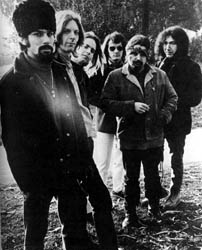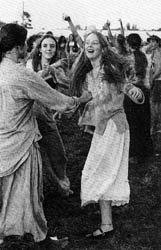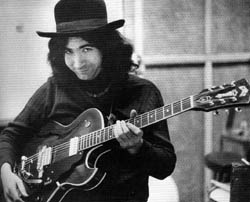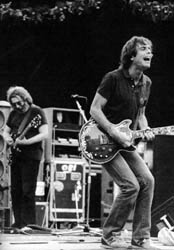[ Previous
| Table of Contents | Next
]
- devotion of "Deadheads"
- share my own experience in Los Angeles at Pauley Pavillion
The Early Years

|
Deadheads
 |
"Captain Trips"
 |
Bob Weir
|
- only a single Top 40 hit - "Touch of Grey" (#9, 1987)
- the band focused on their live show, rather than studio recordings
- built an incredibly loyal following
- Jerry Garcia (guitar) symbolized the "drop
out & turn on" culture
- dropped out of school at 17
- joined the army ... he was discharged after a series of court martials
& AWOLs
- influenced by the folk music rage of the early 60s
- became fascinated with bluegrass
- learned to play 5-string banjo
- began to play coffeehouses
- 1964 - Garcia, along with Ron "Pigpen" McKernan (harmonica &
organ) and Bob Weir (guitar) formed Mother McCree's Uptown Jug Champions
- turned to electric rock under at least partial influence of current
Beatlemania
Haight-Ashbury and the Grateful Dead's "China Cat Sunflower" 
- 1965 - changed name to the Warlocks,
adding Bill Kreutzmann (drums) & Phil Lesh (bass)
- became the house band for Ken Kesey's ("One Flew Over the Cuckoo's
Nest") wild parties
- acid tests - gathering of intellectually liberated
friends, Hell's Angels, and the Warlocks
- predictable constants were drugs (esp. LSD), weird costumes, and loud
rock music
- according to Garcia ... "The acid tests were thousands of people,
all hopelessly stoned, all finding themselves in a roomful of other thousands
of people, none of whom any of them were afraid of."
- this free environment allowed an inordinate amount
of musical experimentation
- distortion, feedback, electronically-generated sounds were all met with
enthusiasm by the stoned audience
- 1966-67 - lived communally (as the Grateful Dead) at 710 Ashbury Street
- playing free concerts regularly
- their name came from an Egyptian prayer that Garcia found in a dictionary
- appeared at Monterey Pop Festival (1967), Woodstock (1969) and Altamont (1969)
- The Dead's repertoire in their early years consisted of blues material,
Motown, soul, and Dylan songs, incorporating:
- extended improvisations
- experimentation (fuzz guitar, feedback, tremelo bar)
- The Grateful Dead (debut album released in 1967) was a relatively
unimpressive effort
- after its release, they added Mickey Hart (drums) and Robert Hunter
(lyricist)
- released two moderately successful albums ... Anthem of the Sun (1968)
and Aoxomoxoa (1969), followed by a live recording Live/Dead
(1969) - considered their best recording of the 60s by Deadheads ... here
are some excerpts ...

[Dark
Star - complete recording of performance on February 27, 1969]
- illustrating lengthy instrumental improvisation, this song is 21 minutes
in length!
- typical of the Dead & other SF groups
- the opening of the song appears to grow out of nowhere
- known for taking an hour to tune up & decide what to play!!
For a detailed discussion & analysis of "Dark Star,"
see the chapter by Boone in Understanding Rock. Listening examples to
accompany this article are provided on this site, simply <click
here>.
example of electronic experimentation
album also contains more typical rock songs …
Turn
on Your Lovelight
- early 70s - the Dead moved in the direction of simplified country, relying
more on acoustic instruments
- exemplified in Workingman's Dead (1970) and American Beauty
(1970) … dramatic shift away from psychedelic rock of the 60s
- Garcia began to play the pedal steel guitar
- established a foundation for country rock
during the summer of 1971, the Dead played as one of the premier acts during the Last Days of Fillmore West
- experienced renewed popularity in the late 80s
- even had a Top 10 single ("Touch of Grey," #9 in 1987) ...
their only Top 10 single
 The Dead as "a family"
The Dead as "a family"
- 8/9/95 - Garcia died in a California treatment center where he had reportedly
gone to kick a heroin dependency
[ Previous
| Table of Contents | Next
]








![]()

